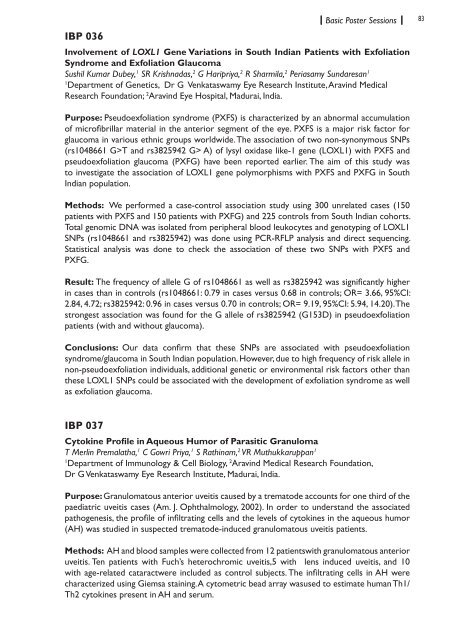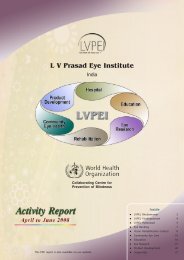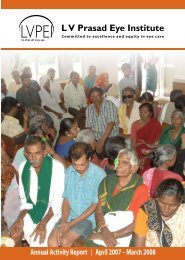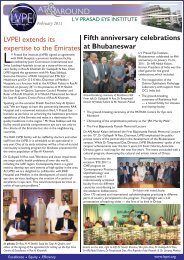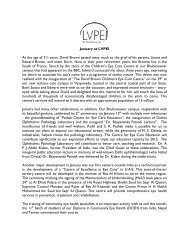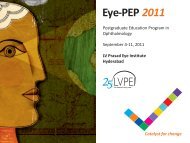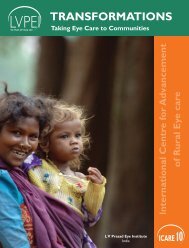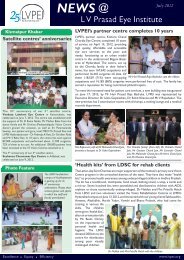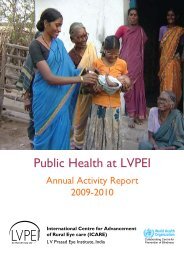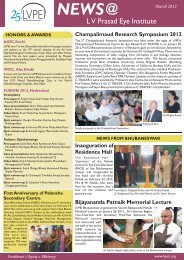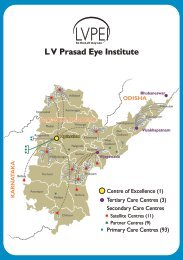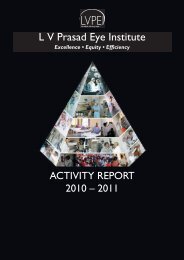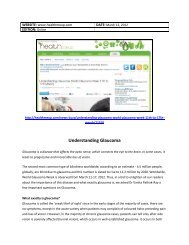IERG Abstracrt Book.indd - LV Prasad Eye Institute
IERG Abstracrt Book.indd - LV Prasad Eye Institute
IERG Abstracrt Book.indd - LV Prasad Eye Institute
Create successful ePaper yourself
Turn your PDF publications into a flip-book with our unique Google optimized e-Paper software.
IBP 036Basic Poster Sessions83Involvement of LOXL1 Gene Variations in South Indian Patients with ExfoliationSyndrome and Exfoliation GlaucomaSushil Kumar Dubey, 1 SR Krishnadas, 2 G Haripriya, 2 R Sharmila, 2 Periasamy Sundaresan 11Department of Genetics, Dr G Venkataswamy <strong>Eye</strong> Research <strong>Institute</strong>, Aravind MedicalResearch Foundation; 2 Aravind <strong>Eye</strong> Hospital, Madurai, India.Purpose: Pseudoexfoliation syndrome (PXFS) is characterized by an abnormal accumulationof microfibrillar material in the anterior segment of the eye. PXFS is a major risk factor forglaucoma in various ethnic groups worldwide. The association of two non-synonymous SNPs(rs1048661 G>T and rs3825942 G> A) of lysyl oxidase like-1 gene (LOXL1) with PXFS andpseudoexfoliation glaucoma (PXFG) have been reported earlier. The aim of this study wasto investigate the association of LOXL1 gene polymorphisms with PXFS and PXFG in SouthIndian population.Methods: We performed a case-control association study using 300 unrelated cases (150patients with PXFS and 150 patients with PXFG) and 225 controls from South Indian cohorts.Total genomic DNA was isolated from peripheral blood leukocytes and genotyping of LOXL1SNPs (rs1048661 and rs3825942) was done using PCR-RFLP analysis and direct sequencing.Statistical analysis was done to check the association of these two SNPs with PXFS andPXFG.Result: The frequency of allele G of rs1048661 as well as rs3825942 was significantly higherin cases than in controls (rs1048661: 0.79 in cases versus 0.68 in controls; OR= 3.66, 95%CI:2.84, 4.72; rs3825942: 0.96 in cases versus 0.70 in controls; OR= 9.19, 95%CI: 5.94, 14.20). Thestrongest association was found for the G allele of rs3825942 (G153D) in pseudoexfoliationpatients (with and without glaucoma).Conclusions: Our data confirm that these SNPs are associated with pseudoexfoliationsyndrome/glaucoma in South Indian population. However, due to high frequency of risk allele innon-pseudoexfoliation individuals, additional genetic or environmental risk factors other thanthese LOXL1 SNPs could be associated with the development of exfoliation syndrome as wellas exfoliation glaucoma.IBP 037Cytokine Profile in Aqueous Humor of Parasitic GranulomaT Merlin Premalatha, 1 C Gowri Priya, 1 S Rathinam, 2 VR Muthukkaruppan 11Department of Immunology & Cell Biology, 2 Aravind Medical Research Foundation,Dr G Venkataswamy <strong>Eye</strong> Research <strong>Institute</strong>, Madurai, India.Purpose: Granulomatous anterior uveitis caused by a trematode accounts for one third of thepaediatric uveitis cases (Am. J. Ophthalmology, 2002). In order to understand the associatedpathogenesis, the profile of infiltrating cells and the levels of cytokines in the aqueous humor(AH) was studied in suspected trematode-induced granulomatous uveitis patients.Methods: AH and blood samples were collected from 12 patientswith granulomatous anterioruveitis. Ten patients with Fuch’s heterochromic uveitis,5 with lens induced uveitis, and 10with age-related cataractwere included as control subjects. The infiltrating cells in AH werecharacterized using Giemsa staining. A cytometric bead array wasused to estimate human Th1/Th2 cytokines present in AH and serum.


